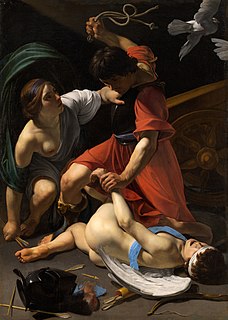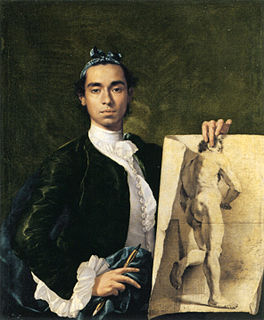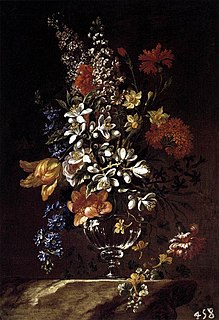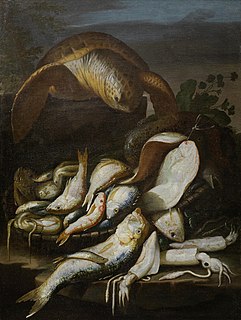
Diego Rodríguez de Silva y Velázquez was a Spanish painter, the leading artist in the court of King Philip IV of Spain and Portugal, and of the Spanish Golden Age. He was an individualistic artist of the Baroque period. He began to paint in a precise tenebrist style, later developing a freer manner characterized by bold brushwork. In addition to numerous renditions of scenes of historical and cultural significance, he painted scores of portraits of the Spanish royal family and commoners, culminating in his masterpiece Las Meninas (1656).

Charles III was King of Spain (1759–1788). He also was Duke of Parma and Piacenza, as Charles I (1731–1735); King of Naples, as Charles VII, and King of Sicily, as Charles V (1734–1759). He was the fifth son of Philip V of Spain, and the eldest son of Philip's second wife, Elisabeth Farnese. A proponent of enlightened absolutism and regalism, he succeeded to the Spanish throne on 10 August 1759, upon the death of his childless half-brother Ferdinand VI.

Anton Raphael Mengs was a German painter, active in Dresden, Rome, and Madrid, who while painting in the Rococo period of the mid-18th century became one of the precursors to Neoclassical painting, which replaced Rococo as the dominant painting style in Europe.

Luca Giordano was an Italian late-Baroque painter and printmaker in etching. Fluent and decorative, he worked successfully in Naples and Rome, Florence, and Venice, before spending a decade in Spain.

The Caravaggisti were stylistic followers of the late 16th-century Italian Baroque painter Caravaggio. His influence on the new Baroque style that eventually emerged from Mannerism was profound. Caravaggio never established a workshop as most other painters did, and thus had no school to spread his techniques. Nor did he ever set out his underlying philosophical approach to art, the psychological realism which can only be deduced from his surviving work. But it can be seen directly or indirectly in the work of Rubens, Jusepe de Ribera, Bernini, and Rembrandt. Famous while he lived, Caravaggio himself was forgotten almost immediately after his death. Many of his paintings were reascribed to his followers, such as The Taking of Christ, which was attributed to the Dutch painter Gerrit van Honthorst until 1990. It was only in the 20th century that his importance to the development of Western art was rediscovered. In the 1920s Roberto Longhi once more placed him in the European tradition: "Ribera, Vermeer, La Tour and Rembrandt could never have existed without him. And the art of Delacroix, Courbet and Manet would have been utterly different". The influential Bernard Berenson stated: "With the exception of Michelangelo, no other Italian painter exercised so great an influence."

Giuseppe Fanelli was an Italian revolutionary anarchist, best known for his tour of Spain 1868, introducing the anarchist ideas of Mikhail Bakunin.

Jusepe de Ribera was a Spanish Tenebrist painter and printmaker, also known as José de Ribera and Josep de Ribera. He also was called Lo Spagnoletto by his contemporaries and early writers. Ribera was a leading painter of the Spanish school, although his mature work was all done in Italy.

Corrado Giaquinto was an Italian Rococo painter.

Maria Amalia of Saxony was born a princess of Poland and Saxony, and became Queen of Naples and Sicily from 1738 until 1759, and then Queen of Spain from 1759 until her death in 1760 by marriage to Charles III of Spain. The arranged marriage produced many children who survived into adulthood, including Charles IV of Spain. A popular consort, she oversaw the construction of the Caserta Palace outside Naples as well as various other projects, and she is known for her influence upon the affairs of state.

Viviano Codazzi was an Italian architectural painter who was active during the Baroque period. He is known for his architectural paintings, capricci, compositions with ruins, and some vedute. He worked in Naples and Rome. He is known in older sources as Viviano Codagora or il Codagora.

Luis Egidio Meléndez (1716–1780) was a Spanish painter. Though he received little acclaim during his lifetime and died in poverty, Meléndez is recognized as the greatest Spanish still-life painter of the 18th century. His mastery of composition and light, and remarkable ability to convey the volume and texture of individual objects enabled him to transform the most mundane of kitchen fare into powerful images.

Francesco Ribalta , also known as Francisco Ribaltá or de Ribalta, was a Spanish painter of the Baroque period, mostly of religious subjects.

Giovanni Do was a Spanish painter, active in Naples.

Andrea Vaccaro was an Italian painter of the Baroque period. Vaccaro was in his time one of the most successful painters in Naples, a city then under Spanish rule. Very successful and valued in his lifetime, Vaccaro and his workshop produced many religious works for local patrons as well as for export to Spanish religious orders and noble patrons. He was initially influenced by Caravaggio, in particular in his chiaroscuro and the naturalistic rendering of his figures.
Blas Olleros y Quintana was a Spanish figure painter and landscape painter who worked primarily in Italy as a watercolorist. He is best known for his Neapolitan scenes and Orientalist works.
Antonio DeVity was an Italian painter born in Naples. His life can be described in a few words: a big passion for painting and art and a great love for Paris, the city where his grandmother's family were originally from. He studied at the Liceo d'Arte in Naples and spent a few years in Paris, in a small attic room near Place Saint-Michel. In those years he had the opportunity to attend the “École des beaux arts”, and to appreciate those places that were often represented in his paintings, including Notre Dame, the Café de la Paix and the Moulin Rouge. During his time in Paris he first started using the pseudonym name "Antonio de Vity". This choice along with giving homage to his beloved Paris, contributed to creating an aura of mystery about the painter. After his return to Naples, Umberto founded a School which rapidly became a prestigious Art Studio, which constituted an important meeting place for artists from Southern Italy.

Francisco Pérez Sierra was a Neapolitan painter of Spanish origin. According to Antonio Palomino, he was the son of a Spanish general. He was a disciple of Aniello Falcone and Juan de Toledo. Numerous works that he painted included the Immaculate Conception, painted in 1655 in the convent of the Trinitarias de Madrid, Santa Ana conduciendo a la Virgen which is now at the Museo del Prado and Saint Joachim which is now at the Museo de Bellas Artes de Granada, he also painted Vase of Flowers in around 1690 which is now at the Royal Palace in Madrid.
Pedro Blanco López, was a Spanish composer, pianist, teacher and music critic.
José Luzán, also José Luzán y Martínez, was a Spanish Baroque painter.

Elena Recco was an Italian still-life painter active in the second half of the 17th century.
















